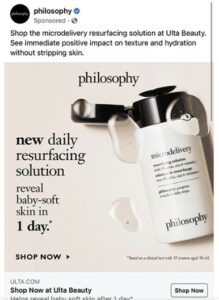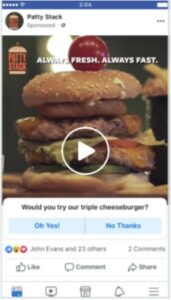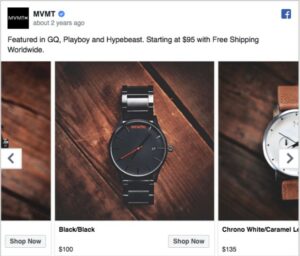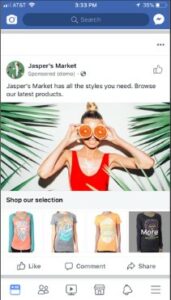This post is part of the: 5-Step Digital Marketing Strategy for Fundraising
Facebook Ad Types
Here are a variety of different Facebook Ads types, and what their specifications, features and benefits are:
1. Image Ads
- Specifications: Single image, maximum 20% text overlay, recommended image size of 1,200 x 628 pixels.
- Features: Simple and effective way to showcase your non-profit’s message or impact, suitable for most campaign objectives.
- Benefits: Cost-effective ad format, high reach potential, and visually appealing to your audience.

How to Optimise Image Ads for Charity Campaigns
- Compelling Visuals: Use high-quality, emotive images that align with your cause, showcasing beneficiaries and positive change.
- Clear Messaging: Craft concise ad copy that complements visuals, conveying mission essence and urgency with a strong call-to-action.
- Consistent Branding: Maintain uniform colours, fonts, and logos to reinforce your charity’s identity and enhance recognition.
- Audience Alignment: Tailor ads to your target demographic’s preferences, reflecting demographics, interests, and behaviours.
- A/B Testing: Experiment with various image versions to determine top performers, refining colours, imagery, and copy.
- Mobile Optimisation: Ensure images are mobile-friendly, clear, and comprehensible on smaller screens due to prevalent mobile usage.
- Minimal Text: Comply with Facebook’s text overlay guidelines, prioritizing visuals for effective message delivery.
- Monitoring and Iteration: Track metrics (clicks, engagement, conversions) to adjust campaigns, optimising outcomes over time.
2. Video Ads
- Specifications: Video format, recommended length of 15-30 seconds, maximum 20% text overlay, recommended resolution of 720p or higher.
- Features: Dynamic and engaging way to tell your nonprofit’s story or showcase your impact, suitable for most campaign objectives.
- Benefits: High engagement potential, increased conversion rates, and cost-effectiveness compared to other video ad formats.

Creating Compelling Video Ads for Charitable Causes
- Hook Within Seconds: Grab viewers’ attention in the first few seconds. Use compelling visuals or a thought-provoking question to entice them to keep watching.
- Tell a Story: Craft a narrative that elicits emotions and conveys the essence of your charity’s mission. Showcase the transformative journey your organisation embarks upon.
- Keep it Concise: Keep your videos concise and focused. Aim for a duration that aligns with viewers’ attention spans—typically under two minutes.
- Show Impact: Clearly demonstrate the positive change your charity brings about. Highlight before-and-after scenarios or showcase real people whose lives have been transformed.
- Strong Call-to-Action: Integrate a clear and compelling call-to-action. Encourage viewers to engage with your charity, whether it’s donating, subscribing, or sharing the video.
- Optimise for Sound-Off: Many viewers watch videos without sound, so use captions or visuals to ensure your message is understood even in silent mode.
- Visual Quality: Use high-resolution visuals and professional editing to maintain a polished appearance and uphold your charity’s credibility.
- Mobile-Friendly: Given mobile device usage, ensure your videos are easily viewable and engaging on smaller screens.
3. Carousel Ads
- Specifications: Multiple images or videos in a scrollable format, maximum 20% text overlay, recommended image size of 1,080 x 1,080 pixels.
- Features: Interactive and engaging way to showcase your nonprofit’s products, services, or impact, suitable for e-commerce or storytelling campaigns.
- Benefits: Increased engagement rates, cost-effective ad format, and the ability to showcase multiple products or services.

Maximising Engagement with Carousel Ads for Charities
- Unified Theme: Maintain a cohesive theme or narrative across all carousel cards. The sequence should seamlessly guide users through a compelling story or journey.
- Beneficiary Showcase: Feature beneficiaries or success stories across cards, highlighting the transformational impact of your charity’s work.
- Step-by-Step Guide: Walk users through the process of getting involved, whether it’s donating, volunteering, or signing up for updates.
- Educational Sequence: Use each card to educate your audience about a specific aspect of your charity’s mission or the issue you’re addressing.
- Progression of Impact: Showcase the stages of your charity’s work, from problem identification to solution implementation.
- Strong CTA: Include a clear call-to-action on each card, guiding users on the next action to take, whether it’s donating, visiting your website, or sharing the ad.
- Variety of Media: Incorporate a mix of images, videos, and captions to maintain user interest and engagement.
- Mobile Optimisation: Given mobile device usage, ensure that the content and visuals are easily viewable and navigable on smaller screens.
4. Collection Ads
- Specifications: Multi-image format with an optional video or an Instant Experience (formerly Canvas) feature, recommended image size of 1,200 x 628 pixels.
- Features: Immersive and interactive ad format that allows users to explore your nonprofit’s products, services, or impact, suitable for e-commerce or storytelling campaigns.
- Benefits: High conversion rates, increased engagement, and a seamless user experience.

Driving Donations through Collection Ads
- Compelling Lead Visual: Feature a captivating video or image as the lead visual to immediately grab users’ attention and evoke emotions related to your cause.
- Story Sequence: Arrange the collection cards to tell a sequential story, starting with the problem your charity addresses and ending with the impact of donations.
- Emphasise Urgency: Communicate the urgency of your cause and the need for immediate action to inspire users to contribute.
- Clear Call-to-Action: Each card should have a distinct and concise call-to-action that guides users towards the desired action—donating or learning more.
- Impact Visualisation: Use visuals to show the tangible impact that donations can make. Highlight before-and-after scenarios or showcase real beneficiaries.
- Engagement Opportunity: Include interactive cards that provide additional information or engage users in a quiz or poll related to your cause.
- Mobile Optimisation: Ensure the ad experience is optimised for mobile devices, as most users engage with content on their smartphones.
- Testing and Iteration: Experiment with different lead visuals, card arrangements, and calls to action. Analyse performance metrics to refine your approach over time.
Why Facebook Ads are Effective for Charities
Facebook has emerged as a powerful platform for charities to amplify their missions and reach a wider audience. A comprehensive comparative analysis of Facebook ads for charities underscores the unique effectiveness and numerous benefits that this platform offers. Let’s delve into why Facebook ads are a game-changer for charitable organizations:
Key Benefits of Facebook Ad Formats for Charities:
- Unparalleled Reach and Targeting Capabilities: Facebook boasts a staggering user base of billions, making it a prime channel to connect with potential supporters. Its sophisticated targeting tools allow charities to refine their audience selection based on demographics, interests, behaviours, and even previous interactions. This precision targeting ensures that your message resonates with the individuals most likely to be passionate about your cause.
- Cost-Effectiveness and Budget Flexibility: Nonprofit organizations often operate within constrained budgets. The cost-effectiveness of Facebook ads can’t be overstated. Compared to traditional advertising mediums, such as print or television, Facebook ads offer a more affordable option with measurable outcomes. Charities can allocate budgets that suit their financial constraints and adjust them as needed to optimise their campaigns.
- Compelling Visual Formats: Facebook ads offer a variety of engaging formats to convey your charity’s story. From image-based ads to video campaigns, the platform enables charities to use visual storytelling to evoke emotions, showcase impact, and drive action.
- Engagement and Interaction: Facebook’s interactive features, such as likes, comments, and shares, provide a means for charities to foster meaningful connections with their supporters. These interactions not only amplify the reach of your ads but also create a sense of community around your cause.
- Performance Metrics and Analytics:
- One of the most significant advantages of Facebook ads is the wealth of data and analytics at your fingertips. Charities can track key metrics like click-through rates, conversions, and engagement levels. This data-driven approach allows organisations to refine their strategies and optimise their campaigns for maximum impact.
- Storytelling Possibilities: Effective storytelling lies at the heart of successful charity campaigns. Facebook ads offer a platform to share impactful narratives that resonate with audiences on a personal level. By conveying the stories of those benefiting from your organization’s efforts, you can inspire empathy and encourage action.
Best Practices for Achieving High Response and Engagement Rates
Here are some best practices for achieving high response and engagement rates with Facebook ad creatives:
- Use eye-catching visuals and strong messaging to grab your audience’s attention.
- Tailor your ad creative to your target audience’s preferences and interests.
- Include a clear call to action to encourage conversions or donations.
- Use high-quality and relevant images or videos in your ad creatives.
- Use Facebook’s ad targeting options to reach the right audience with the right message.
Best Practices for Each Ad Format
Here are some best practices for each Facebook ad format, along with examples of fundraising ads in each format:
Image Ad
- Keep the image simple and easy to understand
- Use contrasting colours and bold text to make the image stand out
Learn more: Awareness Image Ad Specs on Facebook Feed | Facebook Ads Guide
Video Ad
- Use an attention-grabbing opening scene to capture the attention
- Keep the video short and to the point
Learn more: About video ads on Facebook and Instagram
Carousel Ad
- Use high-quality images that are relevant to each other
- Tell a story or showcase your nonprofit’s products or services
Learn more: Facebook Carousel ads: Creating ads with images and text
Collection Ad
- Use an Instant Experience feature to showcase your nonprofit’s impact or mission
- Include a clear call to action within the Instant Experience
Learn more: Facebook Collection ads: Create ads to increase purchases
Facebook offers a range of ad formats for charities to effectively reach their target audience and increase donations. From image ads to collection ads, each format has its unique features and benefits.
By following the best practices outlined in this article, you can create compelling and engaging Facebook ads that resonate with your audience and achieve your campaign objectives.
Remember to regularly review and optimise your ad performance to ensure maximum impact.
If you need any help with your charity’s digital marketing efforts, our digital marketing agency for charities is here to provide expert support and guidance. Contact us today to learn more about our charity PPC agency, charity Google Ads agency or charity SEO agency services.







